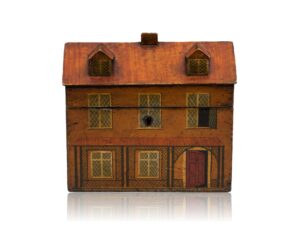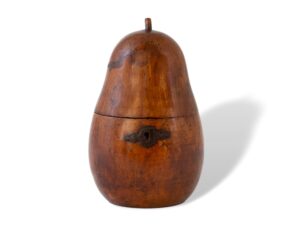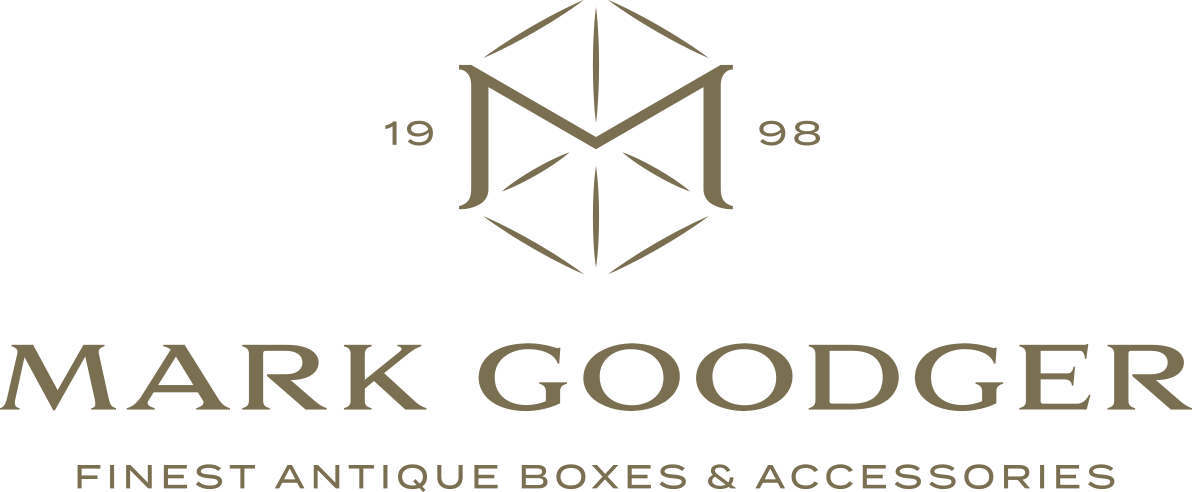
SHAKESPEARE MULBERRY COLLECTION
SOLD
Items carved from Shakespeare's mulberry tree first appear around 1760/1765, with the known fact that the irascible Rev. Francis Gastrell cut down the famous tree in 1756, and time obviously had to be allowed for seasoning it. Shakespeare died in... Read More
| Medium | |
|---|---|
| Country | |
| SKU | 142153 |
Description
Description
Items carved from Shakespeare’s mulberry tree first appear around 1760/1765, with the known fact that the irascible Rev. Francis Gastrell cut down the famous tree in 1756, and time obviously had to be allowed for seasoning it. Shakespeare died in 1616 and the house and the tree became such objects of veneration and attracted so many callers, that the Rev. Gastrell, the 18th-century owner of New Place, became increasingly incensed. As the cutting down of the tree did not decrease the number of visitors, the small-minded cleric demolished the house in 1759. Although so anti-tourist, the Rev. Gastrell had no objection to cashing in on the commercial value of the wood, which he sold to various carvers and turners, anxious to make souvenirs. The principal purchasers were Thomas Sharp, William Hurdis Harborne,
William Hunt, local carvers and general wood craftsmen and a Mr. Pierce; the last was an
ivory turner and jeweller.
A number of varied objects certified by Thomas Sharp as made from the tree, have survived; most of them are elaborately carved and they include small caskets, tea caddies, toothpick cases, goblets, snuff boxes, tobacco stoppers, sugar tongs, etc.’
This is how Edward Pinto, in his seminal book on treen, describes the story surrounding Shakespeare’s Mulberry Tree. Little has been added to this account in recent years and only a very few objects carved from the Mulberry Tree have surfaced on the international market.
Following the destruction of New Place in 1759, Gastrell was forced to leave Stratford “amidst the rage and curses of the inhabitants”. Ten years later, local pride found expression in the Shakespeare Jubilee of 1769. The original impulse was due to John Payton, the landlord of the ‘White Lion’, a genuine enthusiast and a friend of the Shakespearian editor, George Alexander Steevens. In 1768, when Steevens was staying at the ‘White Lion’, Payton invited some of his friends among the leading inhabitants to meet him. The new Town Hall was then just finished and it was regretted that an open niche had been constructed on the north side of it without any prospect of obtaining a statue or even a bust to grace it’. A statue of Shakespeare was suggested as the most fitting adornment and Steevens offered to persuade David Garrick (1717-1779) to present one. The corporation seconded his endeavours by conferring on Garrick the freedom of the borough in a box made from the wood of Shakespeare’s mulberry tree. This led Garrick not only to present a statue of Shakespeare, but to come and organise a Shakespearian festival at Stratford.
At this period of ‘bardolatry’, lead by figures such as Samuel Johnson (1709-1784) and Garrick, objects fabricated from this wood were much prized. The writer, George Keate (who had made the presentation to Garrick) was in turn given an inkstand made from the tree. Examples of pieces bearing the stamp of either George Cooper or Thomas Sharp are known.
The potential for fraud did not go unrecognised. In his play The Jubilee, Garrick presents a tinker selling ‘Toothpick cases, needle cases, punch ladles, tobacco stoppers, inkstands, nutmeg graters and all sorts of boxes made out of the famous Mulberry Tree’, who is challenged by a second trader with the accusation that ‘His goods are made of old chairs and stools and coloured to cheat gentlefolks with’ (Plays, Carbondale and Edwardsville, Illinois: 1980-1982, I, iii, 69-71 and 75-6). Nonetheless, Garrick possessed various pieces manufactured from the wood (and even purchased blocks of timber for himself), thus helping to give these artefacts a genuine and lasting association with the revival of national interest in Shakespeare.
John Marshall was another local carver who established a business carving ‘relics’, he not only obtained wood from the mulberry tree, but expanded the volume of his production by acquiring other timber with direct association to Shakespeare. He was employed on the renovation
of Shakespeare’s Birthplace and removed sections of “damaged” timber during the repair process as well as obtaining timber when New Place was demolished.
Items for sale are as follows:
A very rare carved mulberry wood Shakespeare commemorative tea caddy
Of oval form, circa 1780, the carving of exceptional quality and of a rich fine patination, stamped to the underside of the lid
“Shakespeare’s Wood – Sharp – Stratford-on-Avon” and again to the rim either side of the lock “Shakespeare’s Wood – Sharp – Stratford-on-Avon”.
The lid with a central raised profile of Shakespeare’s face, within two entwined branches of leaves and fruiting mulberry to a punched ground within a guilloche carved border, the lower section intricately carved below the lid with a zig zag and floret frieze over a punched ground, decorated to the front below the lock with a falcon argent supporting a spear
(The Shakespeare family coat of arms) and to the reverse below the hinge with a spear on a shield (The Shakespeare family crest), both within entwined twin mulberry branches with leaves and fruit. The slightly protruding base carved with a guilloche and rope border.
(Minor loss to lock area, with brass hinge and lock plate and steel lock pin)
Width 5 1⁄2 ins (14cm) Height 4 3/8 ins (11cm) Max Depth 3 5/8 ins (9.2cm)
Thomas Sharp, Stratford upon Avon
Thomas Sharp was an enterprising Stratford silversmith, clock and gun maker and was one of the original purchasers of the mulberry tree, he took over the business of the carver George Cooper, who was born in Stratford in 1720. Cooper is mentioned by the Antiquarian John Jordan in his later account of the mulberry tree story. He includes Cooper’s name amongst the buyers of the uprooted mulberry tree and states “he was a poor joiner of Stratford whose curiosity excited him to work what little he was able to purchase into toys such as tea chests, boxes and tobacco stoppers, etc., some of which were prettily carved”.
It is likely that the majority of the mulberry wood carvings bearing Sharp’s stamp were in fact executed by Cooper.
II
A carved mulberry wood Shakespeare commemorative goblet
Of impressive proportions and deep patination, stamped to the base “J. Marshall – Carver – Stratford-on-Avon” and dated “1867”.
The circular foot carved with the inscription “Shakespeare’s Mulberry Wood From New Place” below a carved leaf band and turned pedestal with carved knop, the bowl deeply carved to one side with a head and shoulder bust profile of William Shakespeare, within an oval strapwork cartouche, to the other side with the arms and crest of the Shakespeare family and motto “Non Sanz Droict” (Not Without Right), both on a punched ground divided by carved mulberry leaves and fruits, all below a carved inscription on a raised band “He Lived Not For An Age But For All Time” below an everted rim.
Height 8 6/8 ins (21.7cm) Diameter at base 4 1/8 ins (10.5cm) Diameter at top 3 7/8 ins (9.5cm)
John Marshall, Carver, Chapel Street, Stratford upon Avon
John Marshall was a carver and antiquarian in Stratford upon Avon, who, after the destruction of Shakespeare’s family home by its owner, the Rev. Francis Gastrell in 1759, used wood from the property and in this case the mulberry tree, to create carved artefacts for his shop.
The inscription “He Lived Not……” are the words of Shakespeare’s friend and rival playwright Ben Johnson who wrote “To The Memory of My beloved The Author” for the First Folio of 1623.
Additional information
Additional information
| Medium | |
|---|---|
| Country | |
| SKU | 142153 |


